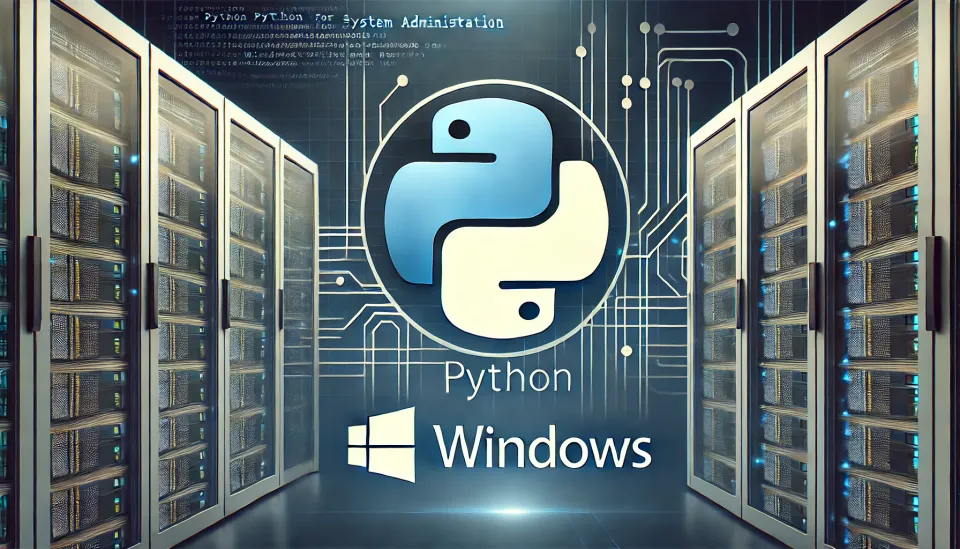Python for System Administration on Windows Servers

If you’re new to the IT world and are looking to streamline your system administration tasks, Python is a fantastic tool to add to your toolbox. Its simplicity, versatility, and extensive library support make it perfect for automating repetitive tasks, managing servers, and enhancing your productivity. Let’s dive into how you can use Python for system administration, particularly in managing Windows servers.
Why Python for System Administration?
- Ease of Use: Python's simple syntax is easy to learn and read, making it an excellent choice for beginners.
- Cross-Platform: While this post focuses on Windows servers, Python works seamlessly across other operating systems. Python scripts can be used on Linux with little refactoring.
- Extensive Libraries: Python has numerous libraries designed specifically for system administration tasks.
- Automation Power: Python can help you automate routine tasks like managing files, checking services, and monitoring resources.
Setting Up Python on Windows
Before jumping into examples, ensure Python is installed on your Windows server. You can download it from python.org. During installation, check the option to add Python to your system PATH for easy access.
Additionally, you might want to install the pip package manager if it’s not included, as it helps you install Python libraries quickly.
Examples of Python in Action
1. Managing Services
Windows services play a crucial role in running background processes. Python’s pywin32 library allows you to interact with these services.
import win32serviceutil
# Check the status of a service
service_name = "wuauserv" # Windows Update service
try:
status = win32serviceutil.QueryServiceStatus(service_name)
print(f"Service '{service_name}' is currently {'running' if status[1] == 4 else 'stopped'}")
except Exception as e:
print(f"Error: {e}")
2. Automating File Management
Python’s built-in libraries make file management a breeze.
import os
# Create a new directory
os.makedirs(r'C:\AdminTasks\Logs', exist_ok=True)
# Move files
import shutil
source = r'C:\Temp\file.txt'
destination = r'C:\AdminTasks\Logs\file.txt'
shutil.move(source, destination)
print("File moved successfully!")
3. Monitoring System Resources
You can use the psutil library to monitor CPU, memory, and disk usage.
import psutil
# Check CPU usage
cpu_usage = psutil.cpu_percent(interval=1)
print(f"CPU Usage: {cpu_usage}%")
# Check memory usage
memory_info = psutil.virtual_memory()
print(f"Memory Usage: {memory_info.percent}%")
# Check disk space
disk_usage = psutil.disk_usage('C:\\')
print(f"Disk Usage: {disk_usage.percent}%")
4. Remote Server Management
Using the paramiko library, you can manage remote servers via SSH. While SSH isn’t native to Windows, you can enable it through OpenSSH Server.
import paramiko
# Connect to a remote server
ssh = paramiko.SSHClient()
ssh.set_missing_host_key_policy(paramiko.AutoAddPolicy())
ssh.connect('remote_server_ip', username='admin', password='password')
# Run a command
stdin, stdout, stderr = ssh.exec_command('hostname')
print(stdout.read().decode())
ssh.close()
5. Scheduled Task Automation
Automate repetitive tasks by creating scheduled tasks using os or subprocess.
import subprocess
# Create a scheduled task
task_name = "DailyCleanup"
subprocess.run([
"schtasks", "/create", "/tn", task_name, "/tr", r"C:\AdminTasks\cleanup.py",
"/sc", "daily", "/st", "02:00"
])
print(f"Scheduled task '{task_name}' created!")
Tips for Getting Started
- Learn Python Basics: Focus on mastering loops, conditionals, file handling, and functions.
- Transition from Powershell to Python: Shift to using Python for small scripting tasks to build muscle memory.
- Explore Libraries: Familiarize yourself with libraries like
os,subprocess,shutil,pywin32, andpsutil. - Practice Automation: Identify repetitive tasks in your workflow and automate them using Python.
- Experiment in a Test Environment: Always test scripts on a non-critical server to avoid unexpected issues. The windows subsystem for Linux is great for testing.
Conclusion
Python is a powerful ally for system administrators, offering the tools to automate tasks, monitor systems, and manage servers efficiently. If you're just starting your career, learning Python will set you apart and open doors to advanced system administration roles.
Start small, experiment, and let Python handle the heavy lifting while you focus on more strategic tasks. The possibilities are endless—happy scripting!